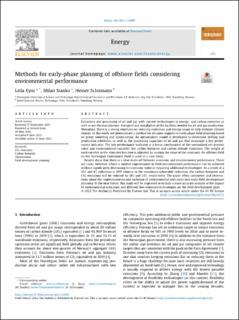| dc.contributor.author | Eyni, Leila | |
| dc.contributor.author | Stanko Wolf, Milan Edvard | |
| dc.contributor.author | Schümann, Heiner | |
| dc.date.accessioned | 2022-10-26T12:09:37Z | |
| dc.date.available | 2022-10-26T12:09:37Z | |
| dc.date.created | 2022-06-27T10:41:39Z | |
| dc.date.issued | 2022 | |
| dc.identifier.citation | Energy. 2022, 256 1-13. | en_US |
| dc.identifier.issn | 0360-5442 | |
| dc.identifier.uri | https://hdl.handle.net/11250/3028436 | |
| dc.description.abstract | Extraction and processing of oil and gas with current technologies is energy- and carbon-intensive as well as are the manufacture, transport and installation of the facilities needed for oil and gas production. Nowadays, there is a strong emphasis on reducing emissions and energy usage to help mitigate climate change. In this work, we demonstrate a method for decision-support in early-phase field planning based on proxy modeling and optimization. An optimization model is developed to determine drilling and production schedules, as well as the processing capacities of oil and gas that maximize a key performance indicator. The key performance indicator is a linear combination of the normalized net present value and environmental variables, the carbon footprint and carbon dioxide emissions. The weight of each variable in the objective function is adjusted by varying the value of the constants. An offshore field on the Norwegian Continental Shelf is used as a case study. Results show that there is a clear trade-off between economic and environmental performance. There are cases, however, where a modest improvement in field environmental performance can be achieved without significantly decreasing its economic value or requiring additional technologies. As a result of a 13% and 8% reduction in NPV relative to the maximum achievable reduction, the carbon footprint and CO2 emissions will be reduced by 30% and 35%, respectively. The paper offers comments and observations about the implementation and inclusion of environmental indicators into early-field development planning. In the near future, this study will be improved to include a more accurate analysis of the impact of environmental indicators and different low-emission technologies on the field development plan. | en_US |
| dc.language.iso | eng | en_US |
| dc.publisher | Elsevier | en_US |
| dc.rights | Navngivelse 4.0 Internasjonal | * |
| dc.rights.uri | http://creativecommons.org/licenses/by/4.0/deed.no | * |
| dc.subject | Field development planning | en_US |
| dc.subject | Optimization | en_US |
| dc.subject | Carbon footprint | en_US |
| dc.subject | CO2 emissions | en_US |
| dc.title | Methods for early-phase planning of offshore fields considering environmental performance | en_US |
| dc.title.alternative | Methods for early-phase planning of offshore fields considering environmental performance | en_US |
| dc.type | Peer reviewed | en_US |
| dc.type | Journal article | en_US |
| dc.description.version | publishedVersion | en_US |
| dc.rights.holder | © 2022 The Author(s). Published by Elsevier Ltd. | en_US |
| dc.source.pagenumber | 1-13 | en_US |
| dc.source.volume | 256 | en_US |
| dc.source.journal | Energy | en_US |
| dc.identifier.doi | 10.1016/j.energy.2022.124495 | |
| dc.identifier.cristin | 2035297 | |
| dc.relation.project | Norges forskningsråd: 296207 | en_US |
| dc.source.articlenumber | 124495 | en_US |
| cristin.ispublished | true | |
| cristin.fulltext | original | |
| cristin.qualitycode | 2 | |

